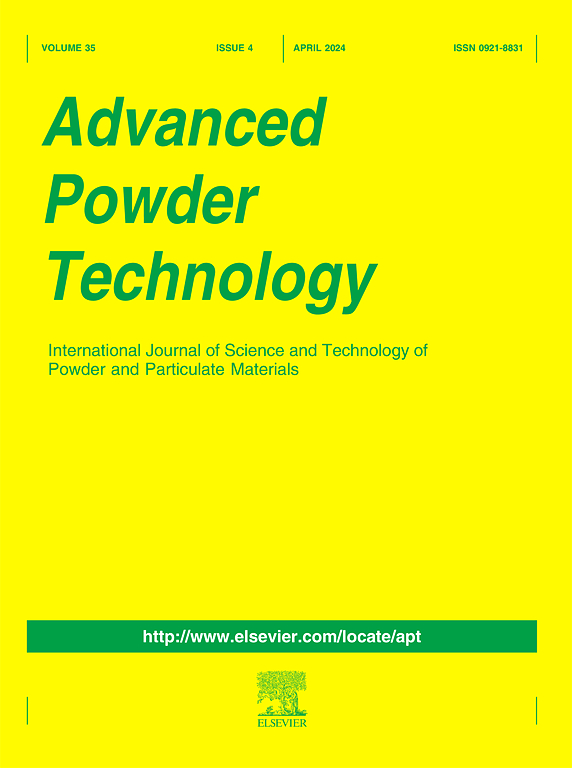NaHCO3和NH4H2PO4对甲烷/煤尘混合物爆燃的抑制作用及反应机理
IF 4.2
2区 工程技术
Q2 ENGINEERING, CHEMICAL
引用次数: 0
摘要
为了丰富不同传统粉末抑制剂对甲烷/煤尘杂化爆燃的抑爆理论,本研究考察了NaHCO3和NH4H2PO4粉末抑制剂对甲烷/煤尘杂化爆燃的抑制作用及其机理。对长焰、焦化和掺9.5 vol%甲烷的无烟煤进行了目视爆燃试验,重点研究了火焰传播、压力演变和残余特性。宏观和微观实验表明,NaHCO3通过在煤表面形成阻碍热解的稳定颗粒,使无烟煤/甲烷混合物(AMM)的动力学生长速率(KG)降低90%,从而有效抑制低挥发性煤尘/甲烷爆燃。NH4H2PO4通过产生抑制中间产物形成的小分子,使长焰煤/甲烷混合物(LMM)的动力学生长速率(KG)降低73.9%。反应动力学模拟表明,NaHCO3通过•NaO+•O=•Na + O2抑制•O自由基,NH4H2PO4通过•PO2+•H +•M =•HOPO+•M抑制•H自由基。本文章由计算机程序翻译,如有差异,请以英文原文为准。

Inhibition effect and reaction mechanism of NaHCO3 and NH4H2PO4 on the deflagration of methane/coal dust mixtures
To enrich the explosion suppression theory of methane/coal dust hybrid deflagration with different traditional powder inhibitors, this study investigates the inhibitory effects and mechanisms of NaHCO3 and NH4H2PO4 powder inhibitors on the deflagration of methane/coal dust hybrids. Visual deflagration tests were performed on long-flame, coking, and anthracite coals mixed with 9.5 vol% methane, focusing on flame propagation, pressure evolution, and residue characteristics. Macro and micro experiments demonstrate that NaHCO3 effectively inhibits low-volatile coal dust/methane deflagration by reducing the kinetic growth rate (KG) of the anthracite coal/methane mixture (AMM) by 90 %, through the formation of stable particles on coal surfaces that hinder pyrolysis. NH4H2PO4, which exhibits greater efficacy with other coal types, decreases the kinetic growth rate (KG) of the long-flame coal/methane mixture (LMM) by 73.9 % by producing small molecules that inhibit the formation of intermediate products. Reaction kinetic simulations demonstrated NaHCO3 inhibits •O radicals via the reaction •NaO+•O=•Na + O2, while NH4H2PO4 suppresses •H radicals through the reaction •PO2+•H +•M =•HOPO+•M.
求助全文
通过发布文献求助,成功后即可免费获取论文全文。
去求助
来源期刊

Advanced Powder Technology
工程技术-工程:化工
CiteScore
9.50
自引率
7.70%
发文量
424
审稿时长
55 days
期刊介绍:
The aim of Advanced Powder Technology is to meet the demand for an international journal that integrates all aspects of science and technology research on powder and particulate materials. The journal fulfills this purpose by publishing original research papers, rapid communications, reviews, and translated articles by prominent researchers worldwide.
The editorial work of Advanced Powder Technology, which was founded as the International Journal of the Society of Powder Technology, Japan, is now shared by distinguished board members, who operate in a unique framework designed to respond to the increasing global demand for articles on not only powder and particles, but also on various materials produced from them.
Advanced Powder Technology covers various areas, but a discussion of powder and particles is required in articles. Topics include: Production of powder and particulate materials in gases and liquids(nanoparticles, fine ceramics, pharmaceuticals, novel functional materials, etc.); Aerosol and colloidal processing; Powder and particle characterization; Dynamics and phenomena; Calculation and simulation (CFD, DEM, Monte Carlo method, population balance, etc.); Measurement and control of powder processes; Particle modification; Comminution; Powder handling and operations (storage, transport, granulation, separation, fluidization, etc.)
 求助内容:
求助内容: 应助结果提醒方式:
应助结果提醒方式:


